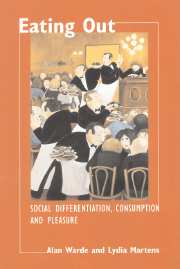Book contents
- Frontmatter
- Contents
- List of illustrations
- List of tables
- Acknowledgements
- 1 Studying eating out
- Part I Modes of provision
- Part II Access
- 4 Patterns of eating out
- 5 Domestic organisation, family meals and eating out
- Part III Delivery
- Part IV Enjoyment: the attractions of eating out
- Part V Conclusion
- Methodological appendix: data collection and analysis
- References
- Index
5 - Domestic organisation, family meals and eating out
Published online by Cambridge University Press: 22 September 2009
- Frontmatter
- Contents
- List of illustrations
- List of tables
- Acknowledgements
- 1 Studying eating out
- Part I Modes of provision
- Part II Access
- 4 Patterns of eating out
- 5 Domestic organisation, family meals and eating out
- Part III Delivery
- Part IV Enjoyment: the attractions of eating out
- Part V Conclusion
- Methodological appendix: data collection and analysis
- References
- Index
Summary
In this chapter, we consider how eating out is related to domestic organisation and speculate whether this relationship has changed over time. Two debates are relevant. The first is the so-called re-negotiation debate, regarding the implications for unpaid domestic work in situations where paid work takes up a substantial part of the time available to couples in households. The second concerns the implications for family life and social cohesion of commercialisation in the food field.
Recent analyses of change and continuity in domestic organisation and housework, without exception, take women's increased employment participation as their starting point. The growth of dual-earner and dual-career households, where both partners are full-time employed, potentially poses a great challenge to traditional arrangements. In such relatively well-to-do households time rather than money may have become the greatest constraining factor in life. This, of course, is not to ignore the simultaneous growth in the number of households where the opposite must be true and lack of money continues to be the primary constraint. Also, in Britain, implications may be limited because 40 per cent of economically active women work only part-time, a popular ‘strategy’ for combining paid and domestic work, but one with less impact on the dominant pattern of household division of labour.
If an increasing number of households now suffer from ‘new’ time constraints (see Gofton, 1990 and 1995, Schor, 1992, Hewitt, 1993), the question is how such households organise their unpaid work?
- Type
- Chapter
- Information
- Eating OutSocial Differentiation, Consumption and Pleasure, pp. 92 - 112Publisher: Cambridge University PressPrint publication year: 2000

